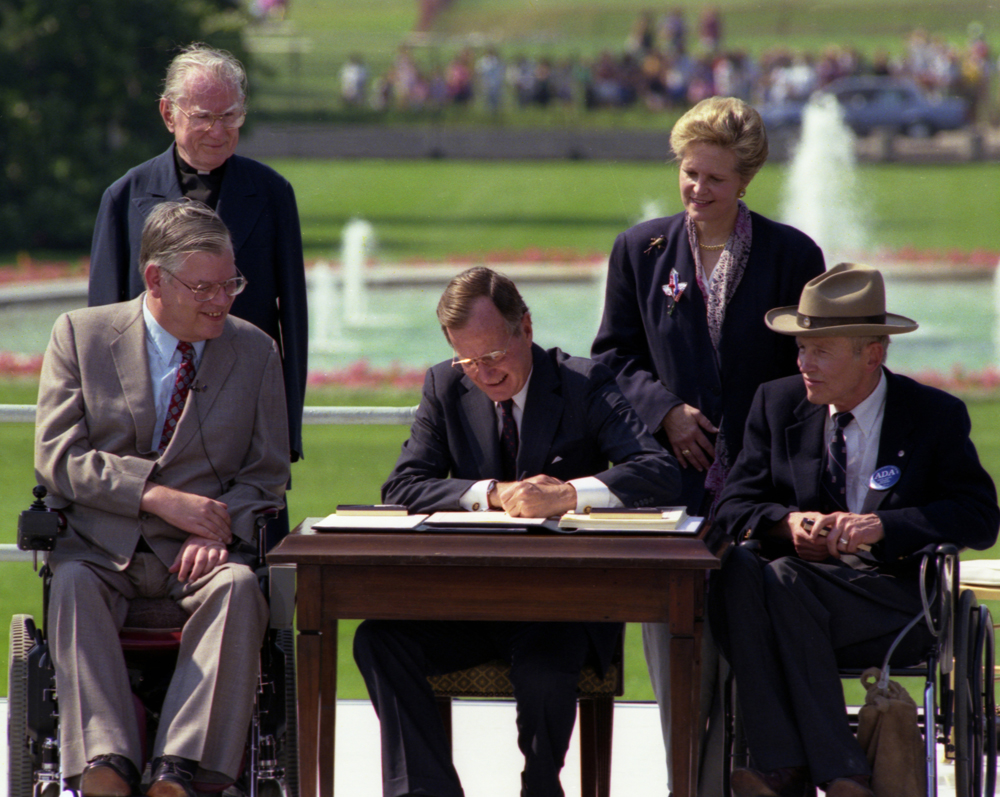
Celebrating 30 Years of the Americans with Disabilities Act
This historic act is the world’s first comprehensive declaration of equality for people with disabilities — the first.
~ George H. W. Bush, remarks on signing the ADA, July 26, 1990
It’s been thirty years since the ADA was signed into law and civil rights protections for people with disabilities were expanded as never before. This year we looked forward to commemorating this historic event with exuberant gatherings – parades, picnics, and lots of people!
Of course, the summer of 2020 hasn’t turned out as any of us hoped it would. The world has been ravaged by the virulent COVID-19 pandemic, and rocked by demonstrations and protests that remind us how much work we still have to do to realize the goals of our civil rights laws. The news boils with death, sorrow, hardship, anger, fear, and strife.
But every day – every single day – there are people helping and supporting each other, generously sharing groceries or offering words of comfort to total strangers, working to make neighborhoods and communities better, and finding creative ways to keep hope and joy alive.
Civil Rights Laws: Signs of Civilization
Though a successful and lasting human society is not based on laws alone, the laws we set for ourselves speak to the accord that flows from our shared humanity. Laws are carefully considered compromises, and must change over time as we learn and grow. As members of society, we follow the law for the good of all. Our innate sense of fairness tells us that our rights come with responsibilities, that we must strive to treat our neighbors as we would wish to be treated ourselves.
… with the precious privilege of being an American comes a sacred duty to ensure that every other American’s rights are also guaranteed.
~ George H. W. Bush, remarks on signing the ADA, July 26, 1990
A civil rights law is a challenge we issue to ourselves – to do better, to be better. Civil rights laws represent the finest aspirations of any society. As disability rights activist Justin Dart said, “ADA is only the beginning. It is not a solution. Rather, it is an essential foundation on which solutions will be constructed.”
In this summer of uncertainty and upheaval, let us pause to reflect on another summer, 30 years ago, when a hot and humid day could not dampen the spirits of the thousands who gathered on the lawn outside the White House to witness the signing of the ADA.
Let us rededicate ourselves to the work that remains to be done to achieve meaningful implementation of all our civil rights laws, until a truly inclusive society is our reality, and every person – regardless of disability, race, religion, gender, language, or any of the other identities we proudly embrace – can breathe the same free air.
Our problems are large, but our unified heart is larger. Our challenges are great, but our will is greater. And in our America, the most generous, optimistic nation on the face of the Earth, we must not and will not rest until every man and woman with a dream has the means to achieve it.
~ George H. W. Bush, remarks on signing the ADA, July 26, 1990
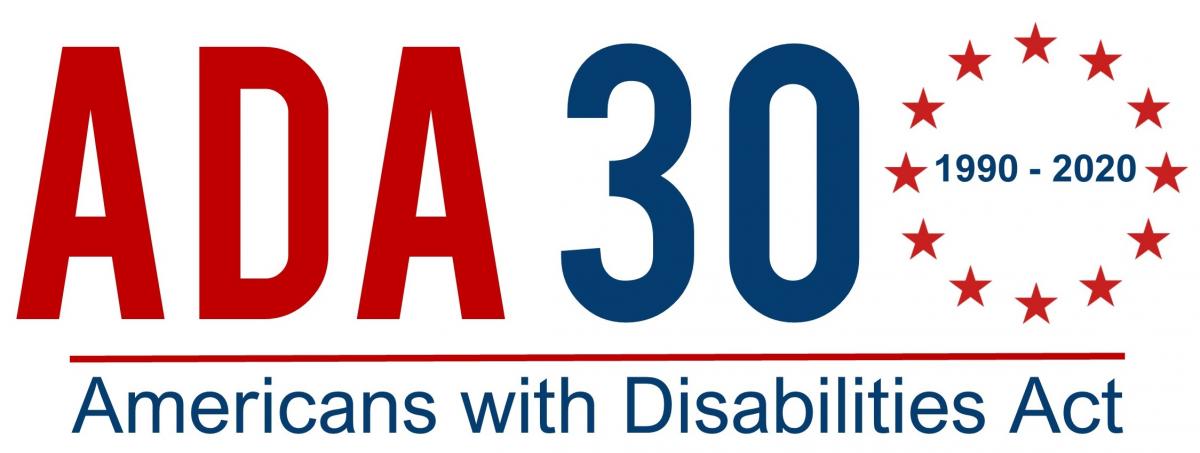
Baltimore Orioles: Celebrate ADA Day
In recognition of the signing of the ADA on July 26, 1990, the Baltimore Orioles hosted “Celebrate ADA Day” at Oriole Park on Thursday, July 26, 2018. The evening’s activities, in addition to a great game under a summer sky, included fun, frivolity, song, and ceremony.

Among the many organizations participating in the event were the Maryland Department of Disabilities (MDOD), Centers for Independent Living, Maryland Developmental Disabilities Council, V-LINC, the Special Olympics, several chapters of The Arc, and Challenger League, a regional organization that provides opportunities for children with disabilities to play baseball.
Singers from ArtStream, an organization that provides inclusive drama and social skills classes to people with intellectual and developmental disabilities, performed the national anthem.
Laura Owens, President of TransCen, threw out the ceremonial first pitch, to none other than Curtis Pride, a Maryland native who was born deaf, played in 421 Major League games, and currently serves as Major League Baseball’s Ambassador for Inclusion.
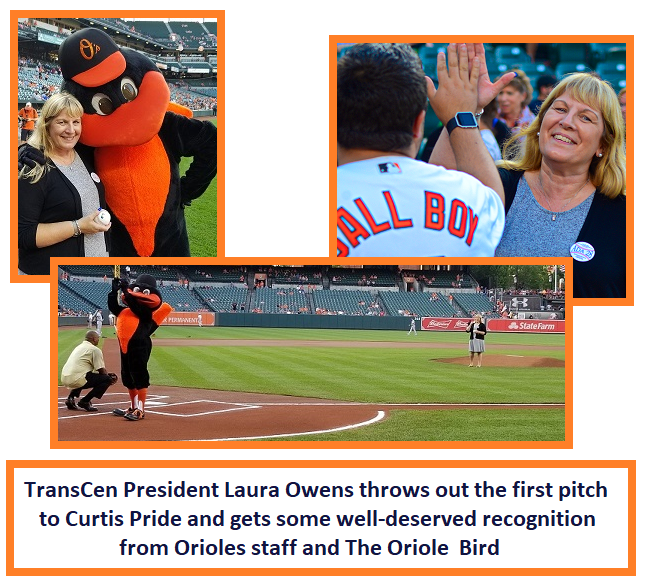
The Orioles also recognized Marian Vessels, the former director of the Mid-Atlantic ADA Center, as a Birdland Community Hero. Marian, who attended the signing of the ADA on the White House lawn in 1990, is known throughout the country as an educator and a leader in the disability community. Find out more about the Orioles’ Birdland Community Heroes Program.(link is external)
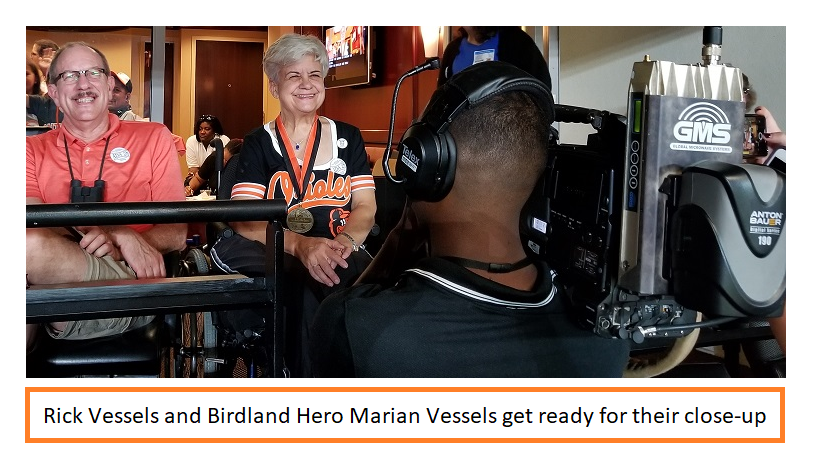
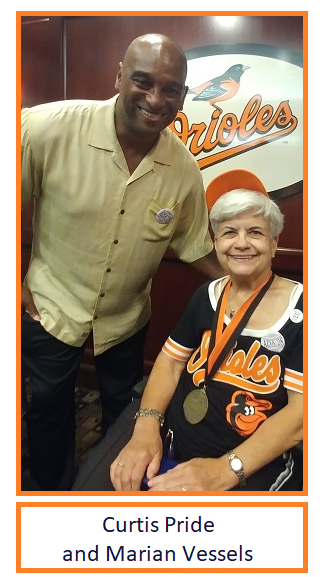
Many of our Mid-Atlantic ADA Center staff, family members, and friends were there as well, along with staff and board members of TransCen, Inc., our parent organization.
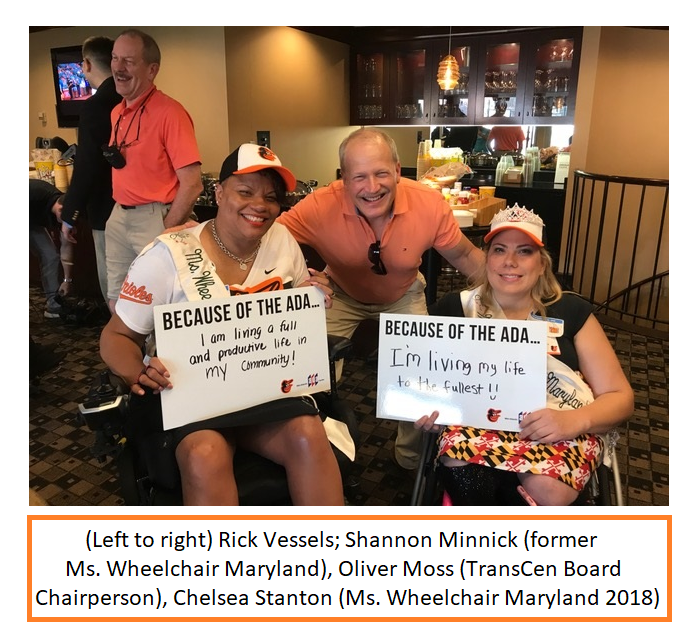
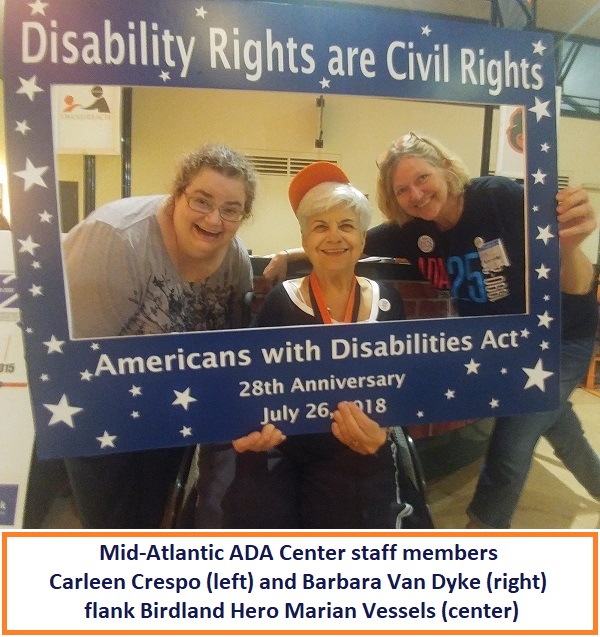
Celebrating ADA25
Our staff, affiliates, and friends around the region participated in a wide variety of events and activities surrounding the 25th anniversary of the ADA, from somber remembrances to sizzling celebrations.
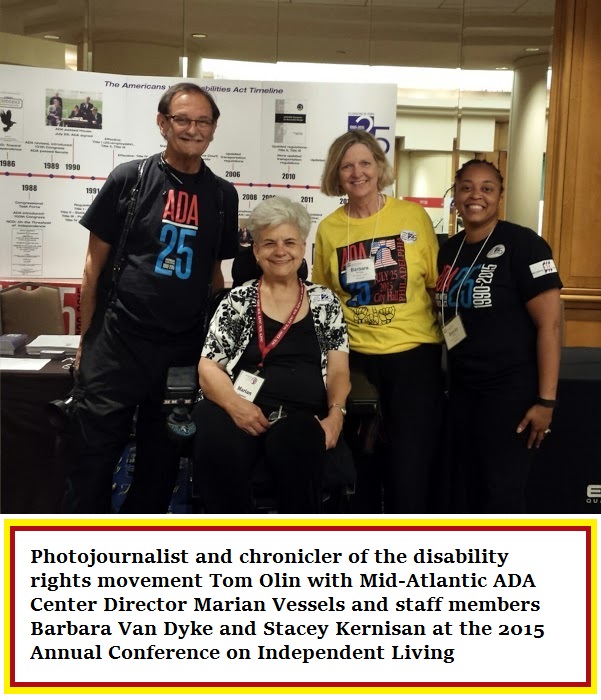
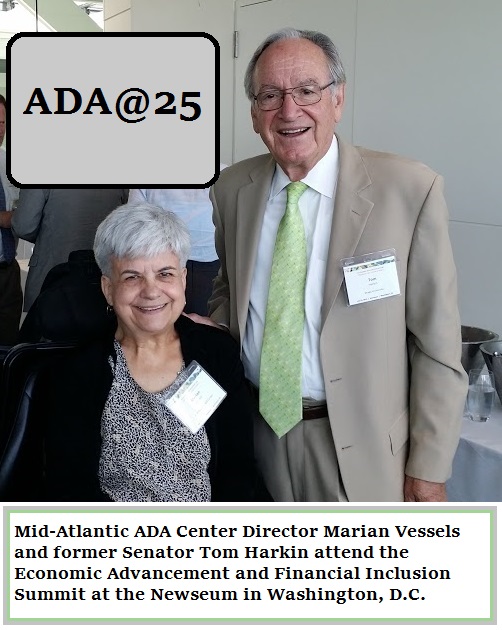
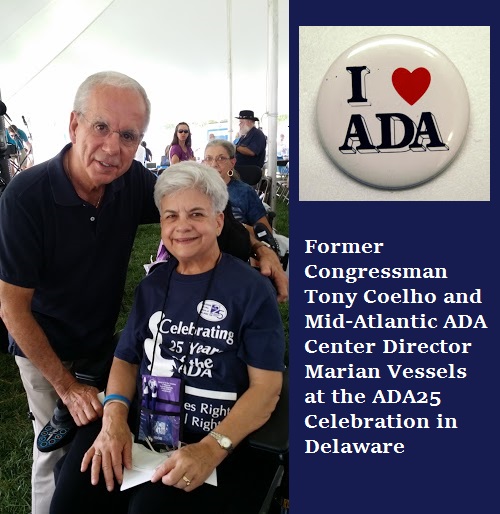
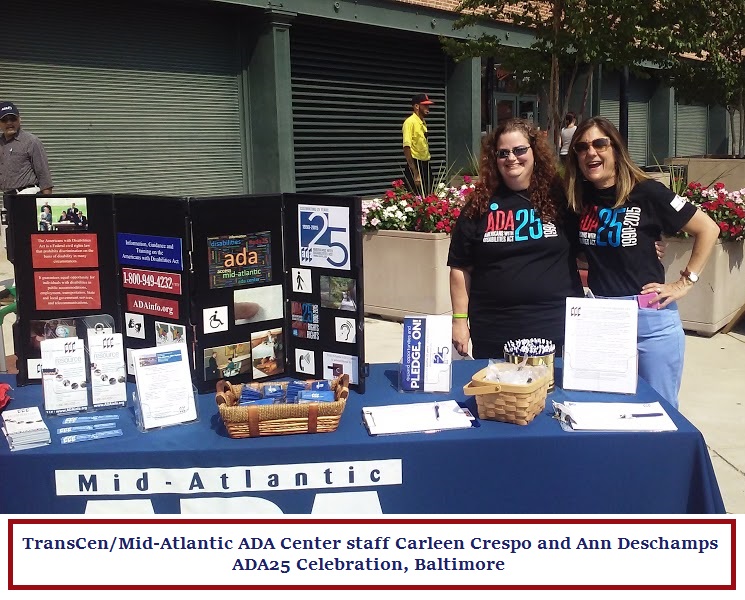
Wings of Equality
Cari Watrous
2015: 25th ADA Anniversary
I think it was the hottest, or one of the hottest, days on the planet. Walking toward the White House, my feet sizzled when they hit the pavement, in part from the sweat running down my legs and in part from sidewalk temp. Never has a walk been so hard, so arduous. Finally there, it resembled my first NCIL conference in the vast diversity of disabilities represented, people using everything from straight canes to being pushed on hospital beds for mobility, sign language flying, people using oxygen masks, white canes and every kind and breed of service animal. An accessible port-a-pot trailer with running hot water. A jogging track that turned walking into a joyous bounce. Friends finding friends in the crowd. And amongst it all, servers in black tux vests and white gloves serving water and lemonade off silver trays.
The huge crowd swelled and then President George H.W. Bush signed “the world’s first comprehensive declaration of equality for people with disabilities.” Goose bumps.
Home, don’t remember coming back, just floating on a high of civil rights, on wings of equality.
My ADA Story
Laureen Summers
2015: 25th ADA Anniversary
Until I left home and built my own life, my world was inaccessible. It was the late 40s and 50s and I was a cute (so they say), starry-eyed girl with cerebral palsy. I walked and talked “funny” (my words). When I was in first, second, and third grades, I attended a school for children with disabilities and remember wondering why I never saw my classmates outside of school. My parents had rejected any connection with disability groups after a newly formed disability association insisted that my condition was quite severe and I would never walk or think properly. Fortunately my parents pursued doctors who contradicted these assumptions. I was raised to function as “normally” as possible.
There was no opportunity to become comfortable with my own disability, let alone that of anybody else. In fourth grade I was mainstreamed and struggled to be accepted by my peers. I no longer associated with anyone, on a personal or friendship level, who had a disability. A family move to Puerto Rico, when I was 10, further isolated me and I grew up dreaming of a perfectly “normal” life even though I was constantly proving my worth to others.
Ralf Hotchkiss, a talented and extremely independent man who uses a wheelchair, appeared in a laundry mat, where I was washing my clothes, in the late 1970s. I was living in Washington, DC and was trying to make some sense out of my rebellious, hippie-strewn life. Through Ralf, who quickly befriended me, I joined the disability community. I found my own voice, met others who challenged my age-old assumptions, and I discovered I was smart. When the writings, arguments, and lobbying for the ADA began, I was ready to become involved.
I didn’t directly participate in the crafting of the ADA, but I knew many people who did. I attended meetings and heard testimony on the hill. I demonstrated with my friends and spoke my thoughts as they struggled to find the right language and figure out how to confront their opponents. I celebrated the victories.
What does the ADA mean to me? It doesn’t deflect from many able-bodied folks’ hesitations and stereotypes. They still exist, although there is much more acceptance of individuals such as myself. Physical access to almost anywhere I want to go, especially as I age, is easier.
In my work of managing an internship program for college undergraduates and graduates with disabilities, majoring in science and engineering, I know that these students, with a wide range of disabilities, now can enjoy full access to professional, cultural, intellectual, and social opportunities that many of us once just dreamed of. And … I think of my young and long-ago classmates with disabilities. They can finally come out to play.
ADA in Action Photo Contest Winners!
EMPLOYMENT CATEGORY
1st place: Bob Amelio
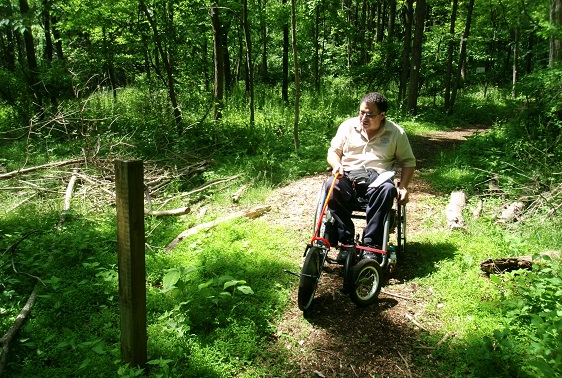
” … performing an ADA site survey on a trail.”
STATE AND LOCAL GOVERNMENT CATEGORY
1st place: Renee Kirby
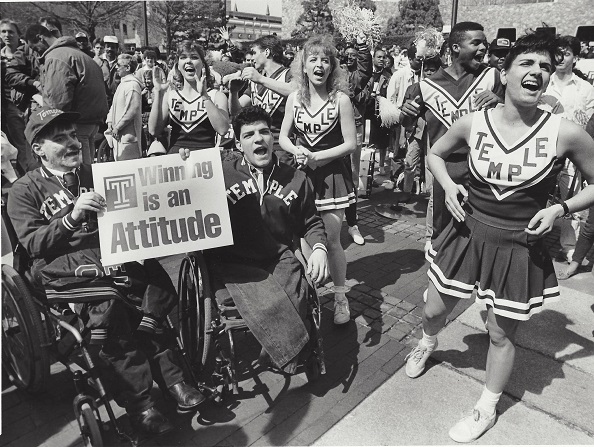
“Inclusion: The ultimate goal of the ADA”
2nd place: Renee Kirby
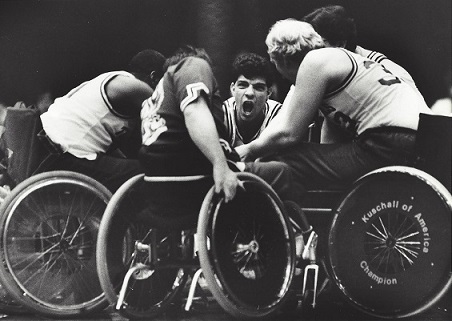
“Collegiate Wheelchair Basketball Team at Temple University in Philadelphia – 1993”
3rd place: Christina Bishop
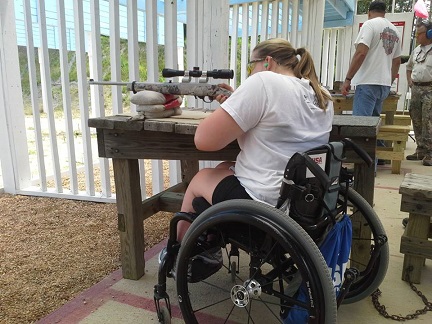
“Kayla Woolridge takes aim! Paralympic Sport Club Southern Maryland and Sanner Lake Sportsman Club offer a day of shooting and archery for individuals with disabilities in St. Mary’s County.”
PUBLIC ACCOMMODATIONS CATEGORY
1st place: Joseph Krycia
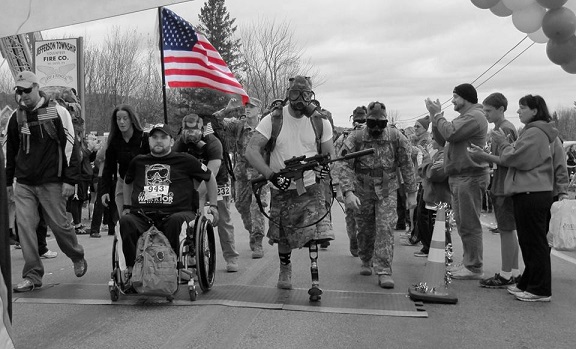
“A ruck march 10K in Scranton Pennsylvania, with members (active duty and retired) of the armed forces at the Veterans Memorial Walk/Run, held in Scranton yearly.”
2nd place: John William Mountjoy
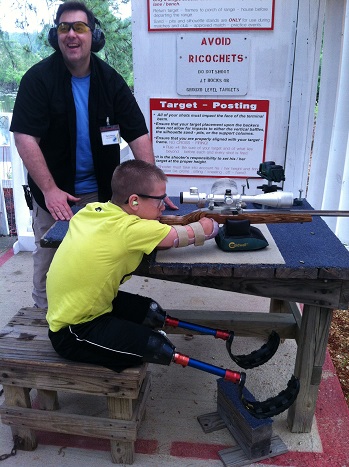
“Coach Chris Sacco reacts to the marksmanship skills of Paralympian-Rifleman Dayton Webber at an event hosted by Sanner’s Lake Sportsmen’s Club, Lexington Park, Maryland. Webber cleared the range of targets in near-record time. Sanner’s Lake Sportsmen’s Club is a private club in southern Maryland that has partnered with the St. Mary’s Count Recreation and Parks Department in becoming one of eight nationwide sponsors of Paralympics/Wounded-Warrior Marksmanship Programs.”
MISCELLANEOUS CATEGORY
1st place: Janetta Green
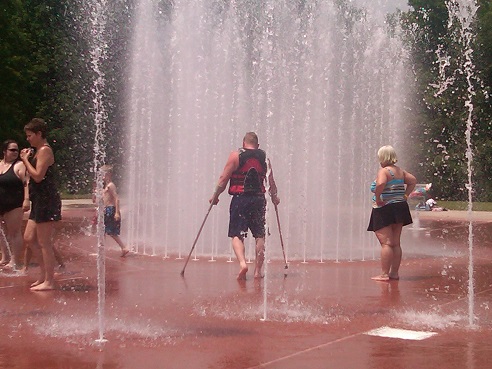
“Center for Independent Living of Central Pennsylvania agency picnic at Little Buffalo State Park, Newport, Pennsylvania.”
2nd place: Donald Balcom
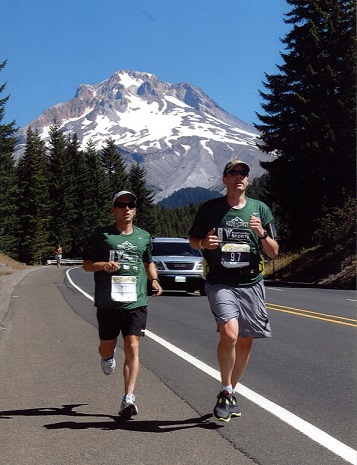
“My first running race as a VI athlete… running in the Hood to Coast Relay race with Wounded Warriors and guided by a local Maryland runner. I finished in the top 5 in my age group in each leg I ran.”
3rd place: Donald Balcom
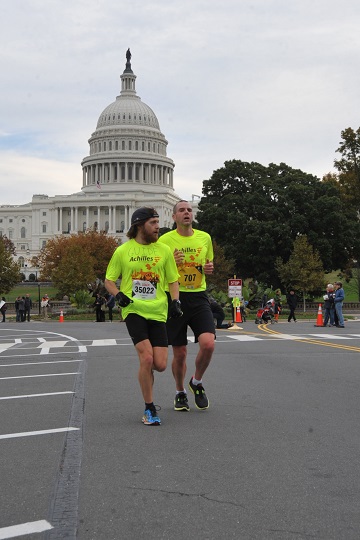
“Visually Impaired: 27-Oct-2013 Marine Corps Marathon – Washington, DC. Overall finish 196 / 23380 in only my second marathon.”
Thanks to all who entered our photo contest and shared such wonderful, creative, truly remarkable photos, and congratulations to our winners!
From ADA in Focus: Spring-Summer 2015:
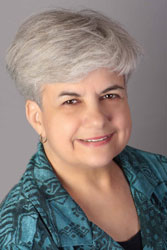
Director’s Corner
from Marian Vessels, Director, Mid-Atlantic ADA Center
Twenty-five years! It hardly seems that long ago that President George H.W. Bush proclaimed that “we must remove the physical barriers we have created and the social barriers that we have accepted” as he signed the ADA into law.
After much debate, negotiation, and compromise, the ADA had been passed overwhelmingly by both houses of Congress. People with disabilities were nearly giddy with excitement and a sense of promise. There was a swell of public approval.
Still, many of us had experienced firsthand those barriers the President talked about – we knew they were high and strong and deep. They would not simply be erased with the flourish of a pen, like a sand castle washed away by a wave. Removing those barriers would take hard work, determination, and time.
We have chipped away at those barriers, bit by bit. People with disabilities have led the way, and government agencies and organizations like ours have provided guidance. Architects have come up with clever designs, and program planners have developed creative approaches to inclusion. Businesses have tapped into a burgeoning market, and employers have realized the benefits of workplace accommodations that enable workers with disabilities to succeed and excel. And the social barriers continue to crumble as people with and without disabilities have opportunities to work and play side by side.
Now with this milestone anniversary, the ADA is again front page news! Let us seize this opportunity, not only to remember and recognize how far we’ve come, but to renew and revitalize our commitment to achieve the full promise of the ADA. Challenges remain; let us rise to meet them. As President Bush so eloquently said on that sunny day 25 years ago:
“Our problems are large, but our unified heart is larger. Our challenges are great, but our will is greater. And in our America, the most generous, optimistic nation on the face of the Earth, we must not and will not rest until every man and woman with a dream has the means to achieve it.”
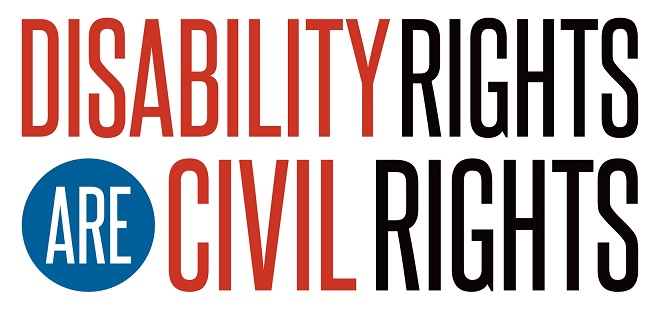
Focal Point: The ADA at 25
 Twenty-five years ago, on a sunny July day in our nation’s capital, thousands of people gathered together to witness an historic moment in the history of the world – the signing of the Americans with Disabilities Act.
Twenty-five years ago, on a sunny July day in our nation’s capital, thousands of people gathered together to witness an historic moment in the history of the world – the signing of the Americans with Disabilities Act.
This year, as we mark this momentous event, we reflect on all that went before – the hard work and collaboration that led to the passage of the law – and all that has followed. Our nation has continued to work, collaborate, debate, and sometimes struggle to implement this challenging law.
Why is it challenging? Certainly the concept at its core – equality of opportunity – is simple enough, yet we have struggled throughout our history to make that concept a reality for groups with more easily defined traits (race, religion, gender). What does equality of opportunity really mean, though, when it comes to people with disabilities? Or, for that matter, who are people with disabilities? Each individual in the world is unique, with strengths and weaknesses, gifts and limitations, so what is disability? Our challenge begins.
ADA in the Courts: Protection
Congress adopted and expanded the definition of disability from the Rehabilitation Act, outlining what have become known as “the three prongs.” People with disabilities include:
- People who have a physical or mental impairment that substantially limits a major life activity,
- People who have a record of such an impairment, or
- People who are regarded as having such an impairment.
Although definitions were also provided for many of the related terms (impairment, substantially limits, major life activity) arguments began to swirl around these issues almost as soon as the ADA took effect.
One of the first ADA cases to find its way to the Supreme Court was Bragdon v Abbott (1998). A dentist, Dr. Bragdon, refused to fill a cavity in his office for a patient who was infected with HIV. One of the central issues raised by the case was whether a person whose HIV “had not progressed to the so-called symptomatic phase” could be considered to have a disability. The court made several significant statements, ruling that an individual with HIV, “[f]rom the moment of infection,” could be substantially limited in reproduction, an activity the court described as “central to the life process itself.”
Despite this expansive interpretation, the Supreme Court narrowed the scope of the ADA’s protections with subsequent decisions. Ruling in 1999 in three separate cases which became known as the “Sutton trilogy” (from Sutton v United Airlines) the court found that the ADA’s definition of disability should take into consideration any corrective devices, medication, adaptive behaviors, or other mitigating measures that people used to help alleviate the effects of their impairments. For example, people often would not meet the definition’s threshold if they took medication that reduced or eliminated the effects of conditions like diabetes, epilepsy, or schizophrenia; if these people were discriminated against because they had these conditions, they had no recourse.
 Congress took back the reins in 2008 by passing the ADA Amendments Act (ADAAA). Finding, among other things, that “the holdings of the Supreme Court in Sutton v. United Air Lines … have narrowed the broad scope of protection intended … eliminating protection for many individuals whom Congress intended to protect,” Congress said disability should be determined without considering the positive effects of medications, assistive devices, or other mitigating measures; the “primary object of attention” should be discrimination.
Congress took back the reins in 2008 by passing the ADA Amendments Act (ADAAA). Finding, among other things, that “the holdings of the Supreme Court in Sutton v. United Air Lines … have narrowed the broad scope of protection intended … eliminating protection for many individuals whom Congress intended to protect,” Congress said disability should be determined without considering the positive effects of medications, assistive devices, or other mitigating measures; the “primary object of attention” should be discrimination.
ADA in the Courts: Coverage
While many defendants argued about who should be protected by the definition of disability, others argued about the extent of coverage. The state of Pennsylvania argued (Pennsylvania Department of Corrections v Yeskey) that Title II of the ADA should not be interpreted to apply to state prisons. The Supreme Court unanimously rejected the state’s arguments and held that the law “unmistakably” covers prisons and all the programs they conduct.
Several states argued that Congress lacked the authority to override states’ immunity with the broad application of Title II. The Supreme Court’s rulings in several cases parsed the application of Title II and the availability of remedies and damages to individuals with disabilities.
The court generally ruled that the application of Title II was valid where Constitutional rights were implicated, as in Tennessee v Lane (2004), a case that raised the issue of physical access to courthouses. The court ruled that access to courts is a “fundamental right” and therefore individuals with disabilities can sue states for damages when that right is violated.
Again in 2006, in the case of United States (Goodman) v Georgia, the court held that an individual can sue for money damages when a state’s discriminatory actions violate the Constitution, which guarantees due process and equal protection under the law. This case arose when an inmate of Georgia’s prison system claimed that he was kept for 23 to 24 hours a day in a cell in which he could not turn around in his wheelchair, was unable to use the toilet or bathing facilities safely and independently, and was denied assistance, medical treatment, and access to virtually all of the prison system’s programs and services. The Court noted that the inmate alleged at least some actions that violated his Constitutional rights.
However, in the case of the University of Alabama v. Garrett (2001), the Supreme Court held that Congress did exceed its authority when it created the potential for individuals to obtain monetary damages from states which violate the employment provisions of the ADA. The Court found insufficient evidence of Constitutional violations by states in relation to employment practices.
Rulemaking and Enforcement
The federal regulatory agencies have not been idle, either. The Equal Employment Opportunity Commission (EEOC), Department of Transportation (DOT), Department of Justice (DOJ), Federal Communications Commission (FCC), and other agencies have worked to update rules, issue interpretive guidance, investigate complaints, and enforce the provisions of the law.
The EEOC has issued a wealth of guidance material and engaged in extensive enforcement activity, processing more than 390,000 complaints and obtaining a variety of relief for aggrieved workers, including $1,290,000,000 in monetary benefits.
The DOT has amended its ADA regulations to address or clarify a variety of issues, including the accessibility of transit stations, bus stops, vehicles, and rail cars, as well as operational issues such as the use of wheelchair lifts on buses and the management of complementary paratransit services. They have conducted dozens of compliance reviews of fixed route and complementary paratransit systems across the country, working with operators to improve services for riders with disabilities.
The DOJ issued new regulations in 2010 to update and expand provisions for state and local government agencies and private businesses, including adopting new design and construction standards for buildings and facilities. The Department’s far-reaching enforcement activities include focused efforts, such as the Olmstead project promoting community integration, the Barrier-Free Health Care Initiative, and Project Civic Access, which has resulted in more than 200 settlement agreements to improve access in towns, cities, and counties around the country.
The FCC has worked to ensure that telecommunications relay services keep pace with technological advancements and continue to enable individuals with disabilities to effectively access the telecommunications network.
Where Do We Go from Here?
 Federal research and rulemaking continue to address emerging issues. The U.S. Access Board is working on formulating or updating guidelines for accessible passenger vessels, buses and vans, rail vehicles, public streets and sidewalks, and medical diagnostic equipment.
Federal research and rulemaking continue to address emerging issues. The U.S. Access Board is working on formulating or updating guidelines for accessible passenger vessels, buses and vans, rail vehicles, public streets and sidewalks, and medical diagnostic equipment.
ADA regulatory agencies continue rulemaking and enforcement efforts to expand or clarify the application and implementation of the law. The EEOC has recently proposed to amend their rules to address employer-sponsored wellness programs. The DOJ has begun rulemaking to address captioning and audio-description in movie theaters, web-based information and services, and equipment and furniture such as medical and exercise equipment, accessible golf cars, portable ATMs and point of sale (POS) devices, and beds in hotels, hospitals and nursing homes.
Perhaps in another 25 years we will look back on a whole new series of developments and achievements that have advanced accessibility, opportunity, and inclusion. But this year we celebrate how far we’ve come. We salute those who refused to be marginalized, excluded, and dispossessed, and those who stood with them. We thank those who challenged us to give meaning to our words, to breathe life into our pledge that there is liberty and justice for all in America.
Reflections of the Past, Present, and Future: 20th Anniversary of the ADA
20th Anniversary of the ADA! Hard to believe it has been 20 years. It does not seem that long ago that I was sitting at the signing ceremony with 3,000 others at the largest bill signing ceremony in U.S. history. So large that it had to be held outside on the White House lawn with the typical hot, humid weather for which the Washington area is notorious. The crowd was an amazing assortment of people from all over the country and with all types of disabilities. The atmosphere was electric with the sense that something incredible was happening.
I can’t help but reflect on the significance of that day, and the struggle that was fought by many of those present at the signing of the ADA into law. The disability rights movement grew in the early 1970s as a result of the need for anti-discrimination protections and accommodations for individuals with disabilities. It was a grassroots effort lead by people with disabilities. It was a time in our history rich with challenges as well as successes.
What will the next 20 years look like? Although it is difficult to predict, there are some real signs of change. … The ADA will take on a new face with the Americans with Disabilities Act Amendments Act (ADAAA). … The ADAAA makes it easier for an individual alleging discrimination based on disability to establish that he or she meets the ADA’s definition of “disability.”
The number of Americans with one or more physical or mental disabilities is large and growing. This is partly due to our aging population. As individuals reach their 60s and 70s the incidence of disability rises sharply. However, the disability community is diverse in its representation, and the ADA exists to protect all of the approximately 54 million Americans with disabilities from discrimination.
The passage of the ADA 20 years ago is reason for celebration. It is important to celebrate our successes over the past 20 years, successes that President George H.W. Bush predicted during the signing of the ADA in 1990 as he said; “With today’s signing of the landmark Americans with Disabilities Act, every man woman and child with a disability can now pass through once closed doors, into a bright new era of equality, independence and freedom.” … Many positive changes have taken place as a result of the ADA. As we celebrate 20 years of the ADA on July 26, 2010, it is also important to reflect upon the work that still remains to be done. We need to continue to address those areas where we fall short in the equal treatment of all Americans. … Let’s unite in the cause of equality, independence and freedom.
Reflections on a Promise
Mrs. Vessels also offers a very personal view on the importance of such a momentous event in a short video published on YouTube. The clip is from a 22 minute video, “Reflections on a Promise” which is available for loan from the Center.
Video of the Signing of the Americans with Disabilities Act; July 26, 1990
“Together, we must remove the physical barriers we have created and the social barriers that we have accepted. For ours will never be a truly prosperous nation until all within it prosper.”
~ President George H.W. Bush
Check out these other videos:
[NOTE: These video links are being offered as a service. The ADA Center cannot guaaurantee that all videos are properly captioned.]
Following are excerpts from testimony given at a congressional hearing on September 27, 1988, urging Congress to pass the Americans with Disabilities Act.
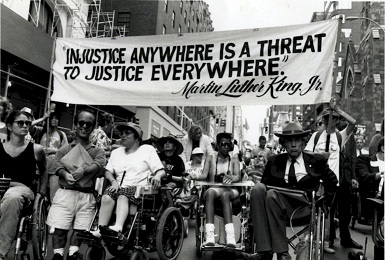
Mary Linden:
I want my 4 year degree so that I can go … for the most precious thing in the world, a paying job.
At 7 years of age, I entered the Jesse Spalding School for the Crippled, a venerable institution of the Chicago school system … they never even taught me to write. I learned to print after, I taught myself to print after I finished high school … in 1951.
No career plans or educational plans were made for me because the school and my parents thought I was too disabled to compete. I have been after my education for 20 years. I got most of it after transportation became accessible, after a fashion that is.
I want my 4 year degree so that I can go … for the most precious thing in the world, a paying job.
I beg of you to pass this act, so that other children will not have to go through what I went through, will not be stared at, will not be limited … It will not be once every 6 months that we get to go shopping. If we pass it, we can go stare at the glass windows any time we want to.
The youngsters here will have much more chance than I did, but they should have a chance to work and to contribute as much as they can.
Jade Calegory:
It is hard for people to feel good about themselves if they have to crawl up the stairs of a bus, or if the driver passes by without stopping.
My name is Jade Calegory. I am 12 years old …
I was born in 1976, 200 years after the Constitution promised freedom and independence for all of us, no matter what. Thanks to you, and the people who sat in those seats before you, I am lucky to grow up in a world that is different than when you folks were kids. Thanks to you, people are not separated as much by their age, religion, color of their skin, disability, whether they are men or women, stuff like that. Things are getting better, but it sure does take a long time.
Even though some things have gotten better, there is more that can and should be done.
I guess that is why I am here today, not because America’s 36 million citizens are physically challenged, but because we are also politically challenged.
I like racing in my wheelchair. I have won 5K and 10K races. After my mom and I go jogging on the beach back in California, we sometimes take the bus back home, or at least we try to. Most of the buses do not have lifts on them. Some of the drivers are very rude and get mad if I want to take the bus. Can you believe that?
I work and part of my taxes pay for public buses and then they get mad just because I am using a wheelchair. I do not think that is fair or right. I am important, too.
Anyway, I was thinking, if all of the buses had lifts on them, it would be better for all of us. It is hard for people to feel good about themselves if they have to crawl up the stairs of a bus, or if the driver passes by without stopping.
I guess my teacher was right about history repeating itself. I learned in school that black people had problems with buses, too. They had to sit in the back of the bus, but some of us with disabilities cannot even get on the bus at all.
Lakisha Griffin:
Some people will think that I cannot be a teacher, but I know I can.
My name is Lakisha Griffin … I am 14 years old and a seventh grader at the Alabama School for the Deaf and Blind in Talladega, Alabama.
Discrimination is a big word, but I can tell you that it is real, and I hope Congress will do something about it.
I am the youngest of six children. Until 2 years ago, I was educated at home by my two older sisters. Lafayette is a small rural town in Alabama, and my family did not know much about opportunities for blind people like me.
My life changed a lot in 1986, when I enrolled at the Alabama School for the Deaf and Blind in Talladega. I … learned Braille … and that has opened up a new world of knowledge for me.
When I grow up, I want to go to college to become a teacher. I want to teach Braille to other blind people, since the knowledge of Braille has been so useful to me.
I know that I can become a Braille teacher if I study hard. My parents have worked hard in the textile mill, and I know that I must also work hard to get ahead in life. I hope to be the first person in my family to go to college. I am worried, however, that people will treat me differently because I am blind, black, and female. Some people will think that I cannot be a teacher, but I know I can.
I do not need sympathy. I do not need prejudice. I do need a fair chance to get a job and live independently. Discrimination against blind and other disabled people must be eliminated, and the Americans with Disabilities Act will help that happen. People pay attention when it is the law.
Belinda Mason:
You cannot legislate good manners. But you can legislate recourse for some forms of discrimination.
Until early last year, my family and I had an average life near one of America’s thousands of average small country towns. We juggled our jobs, our daughter, and our credit card payments. Our pleasures were simple and common, a walk in the woods, a new song on the radio, or a cookout with other young families.
But then my life changed dramatically. While delivering our healthy son, I suffered serious complications, including cardiac arrest and a stroke. Because of massive hemorrhaging, I received numerous transfusions of blood products. One unit was later found HIV positive and in March 1987, my own blood first tested positive for antibodies to the HIV virus, the virus that causes AIDS.
With that diagnosis, I became a person with a “hidden disability,” a disability just like epilepsy and diabetes and tens of other disabilities. And just like people with those other hidden disabilities, I became subject to irrational and unjustified discrimination.
The average life I once enjoyed has vanished. And since I have been living with HIV, I have learned a terrible truth about America, that it is not a good place to be different or to be ill, in spite of what we teach in government class.
… the whole world just shifts around you. You are not … a Kentucky basketball fan anymore. You are not a writer. You are not anything else. You turn into a person with a disease, a person with a disability. Whatever else that there was about you is just ignored.
There are some things that legislation, by its nature, cannot and will not do.
… this bill probably would not have helped me when my next door neighbor in Indiana, a registered nurse, carried a petition to every neighbor on the block, demanding that my family and I move. You cannot legislate good manners. But you can legislate recourse for some forms of discrimination. By legislating that protection, perhaps you may also help promote reason and foster more decent treatment. The truth is that sometimes legislation precedes and enhances humanity.
Greg Hlibok:
… we would like to participate equally and to be effective in society, not to be ignored.
… captions, TTYs, qualified interpreters, note takers, and visual aids, and these type of things would reduce the communication barriers that we face. It is not simply just accommodations, but we would like to participate equally and to be effective in society, not to be ignored.
We do not want sympathy, we want support. Because we can help ourselves if things are accessible for us. All we ask for is that you let us guide our own destinies.
Representative Tony Coelho:
The exclusion and segregation of people with disabilities has had an insidious partner: the gloss of good intentions.
The National Council on the Handicapped (now the National Council on Disability, or NCD) conducted innumerable hearings and forums across this country and reached the same inescapable conclusions again and again: barriers and discrimination, rather than the inherent physical or mental characteristics of persons with disabilities themselves, are to blame for the staggering unemployment and isolation of these citizens, our nation’s largest minority.
[Unemployment among people with disabilities] is not viewed as a solvable problem, it’s viewed as an inevitability.
The exclusion and segregation of people with disabilities has had an insidious partner: the gloss of good intentions. An atmosphere of charity and concern has cloaked our ill-treatment of disabled people and permeated our excuses for denying them access to the full benefits of the complex fabric of modern American society. The institutions and the token van rides and the overprotective denials of employment have all been provided with the noblest intent.
While the charity model once represented a step forward in the treatment of persons with handicaps, in today’s society it is irrelevant, inappropriate and a great disservice. Our model must change.
Representative James Jeffords:
Starting today, we must work together to make the ADA a fact, not a gesture; reflected in practice, not promises; and grounded in commitment, not hope.
We continue the process of transforming the ADA into law. Its effects should not be judged in terms of cost, but rather realized potential; not be measured in terms of effort, but in increased productivity; and not be characterized as preferential treatment, but as reaffirmed human dignity. Starting today, we must work together to make the ADA a fact, not a gesture; reflected in practice, not promises; and grounded in commitment, not hope.
History of the ADA
The Civil Rights Movement of the 1960s gave rise to other civil rights movements, most notably the Women’s Rights Movement and the Disability Rights Movement. While minorities and women were protected by civil rights legislation passed by the United States Congress during the 1960s, the rights of people with disabilities were not protected by federal legislation until much later. Read more about the history of the ADA.